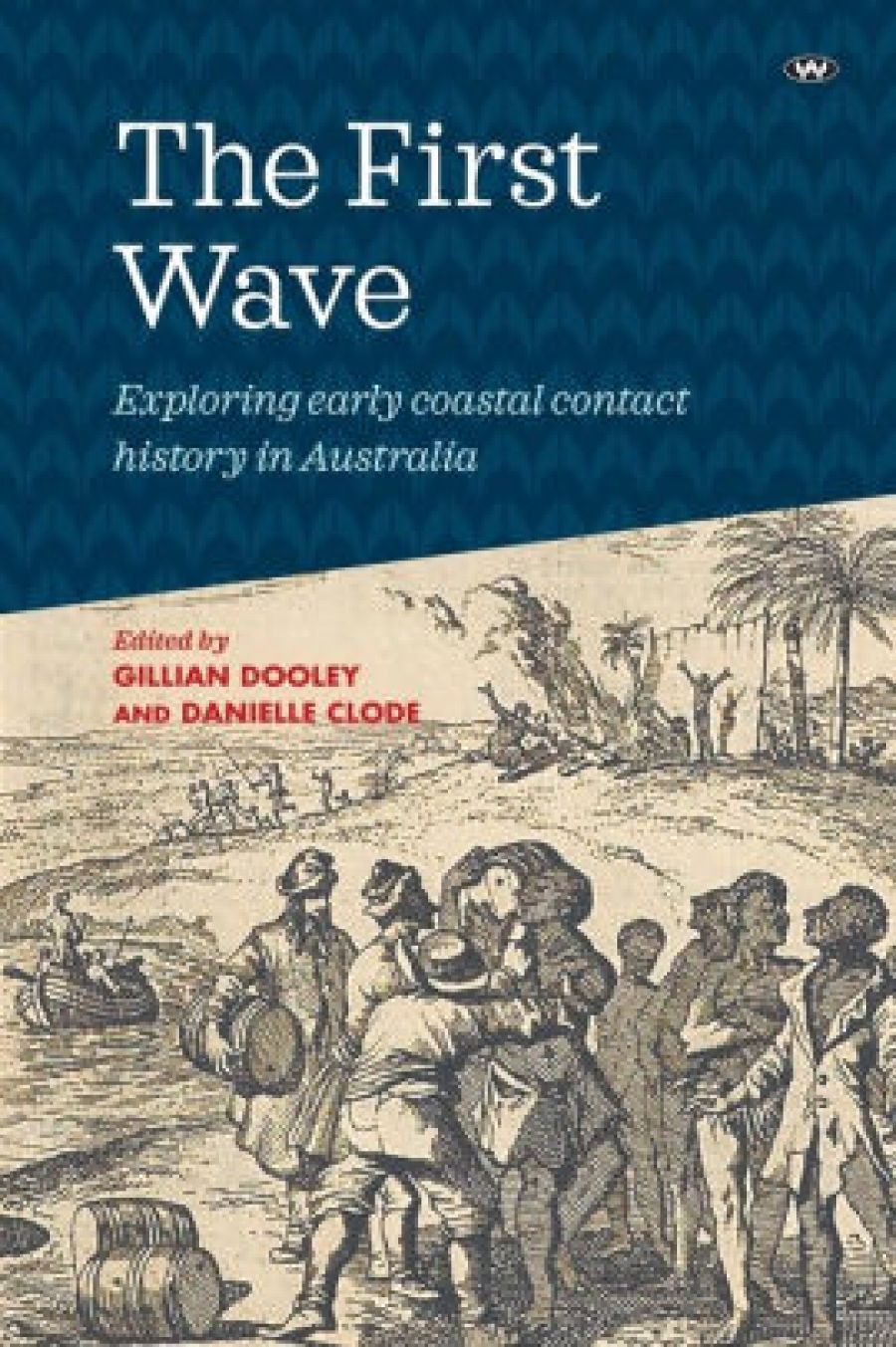
- Free Article: No
- Contents Category: History
- Review Article: Yes
- Custom Highlight Text:
First encounters between Indigenous Australians and European voyagers, sealers, and missionaries often unfolded on the beach, a contact zone where meaning and misunderstanding sparked from colliding worldviews. This sandy theatre also serves as one of the enduring metaphors of ethnographic history, a discipline that reads through the accounts of European explorers, diarists, and administrators to reconsider historical accounts of the gestures of Indigenous people from within their own cultural frameworks.
- Grid Image (300px * 250px):

- Book 1 Title: The First Wave
- Book 1 Subtitle: Exploring early coastal contact history in Australia
- Book 1 Biblio: Wakefield Press, $49.99 pb, 452 pp, 9781743056158
The First Wave: Exploring early coastal contact history in Australia emerges from this tradition and adds a twist by bringing together chapters of granular historical research with offerings from anthropology, cultural studies, poetry, and fiction. The editors – Gillian Dooley (a literature academic) and Danielle Clode (an interdisciplinary scholar) – position fine historical craftsmanship by writers including Skye Krichauff, Valerie Munt, and Mark Dunn alongside poems by Yankunytjatjara writer Ali Cobby Eckermann and an extract from Kim Scott’s That Deadman Dance, among other works. Through these twenty-seven pieces, we taste the salt spray glancing off the glossy backs of dolphins and whales, commune with juvenile dingos and castaways on K’gari (Fraser Island), and learn the devastating stories of Aboriginal women abducted and traded by the often-sadistic sealers of Kangaroo Island and Bass Strait. These historical episodes sit cheek by jowl with essays about how first encounters – especially those of Captain Cook – ripple through the cultural practices of contemporary Indigenous Australians in art, writing, music, and performance.
At its most powerful, The First Wave twines rich accounts of the past with a deep understanding of the country and cultures of particular Indigenous groups.
A reprint of an intriguing account published in 1998 by the late Torres Strait leader George Mye (pen name Eidi Wakaisu) about the arrival of missionaries on the island of Erub demonstrates the force of oral histories for recounting the past from the other side of the frontier, and lures non-Torres Strait readers to ‘come across’ to interpret words and ideas from the local language. The accompanying analysis by Anna Shnukal deepens our understanding of this work by outlining the storytelling methods of Erub, and suggests that Mye mobilised particular kinship rights through his choice of pen name.
In an equally compelling piece, Aaron Corn and Brian Djangirrawuy Garawirrtja assemble archaeological evidence and oral and written histories to explore extensive Yolŋu contact with Makassan fishermen in northern Australia. They show how Yolŋu integrated these histories into songs and culture as political statements of sovereignty, including during the charged bicentenary of colonisation in 1988.
Standout pieces amid the poems and fictional works include Clode’s shining contribution, in which she reimagines the relationships between Yuin, orcas, and European whalers in Twofold Bay, New South Wales, through the fictional perspective of a Yuin girl. Meanwhile, a gripping extract from Catherine McKinnon’s 2017 novel Storyland portrays the fraught 1796 voyage of George Bass, Matthew Flinders, and fifteen-year-old servant Will Martin as they bobbed south of the fledgling colony of New South Wales and, posits McKinnon, misinterpreted acts of assistance by a local Indigenous group as aggression.
Dooley and Clode intend these diverse works to speak to a general audience at a time when a celebratory history of European arrival serves as the bedrock of a conservative political agenda. Yet the volume’s introduction (brief at three pages) could have done more to contextualise the plurality of these offerings by explaining how they speak to one another, and by outlining crucial historical and geographical background – signposts to help readers navigate three centuries on a giant continent. The volume would benefit from an overview of the debates and dynamics around how we tell contact and invasion histories, including the growing influence of evidence from oral history and archaeology, and the persistent question of who gets to tell these stories. In particular, readers might appreciate a discussion regarding what the historian Tom Griffiths has called ‘the necessary and creative tension between history and fiction’. Many of the individual authors work hard to set the scene for their contributions: Rowena Lennox, for example, deftly evokes K’gari in a history of dingo–human and Indigenous–European relations. But the book as a whole sometimes drifts from site to site without the rudder of time and context.
Within this mélange, an intricate intellectual history of the Portuguese-born Spanish explorer Pedro Fernández de Quirós by Daniel Hempel seems out of place in tone for a general audience. And anthropologist Peter Sutton’s narrative of the nineteen-day overland journey in Cape York in 1927 by missionaries William and Geraldine MacKenzie, anthropologist Ursula McConnel, and Wik companions feels like a slideshow: marvellous photographs, maps, and diary entries, as well as the fruits of Sutton’s own deep engagement with the Wik peoples, float free of crucial contextual information about the sojourners, Cape York history, or Sutton himself.
The First Wave therefore arrives as a vessel bearing mixed cargo. Persistent non-academic readers may well climb aboard, and will relish the rewards. Or perhaps this volume will primarily offer passage to scholars and students searching for an encounter with just one or two works, a moment of understanding fished from the depths of a library catalogue.


Comments powered by CComment